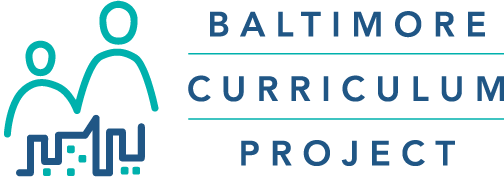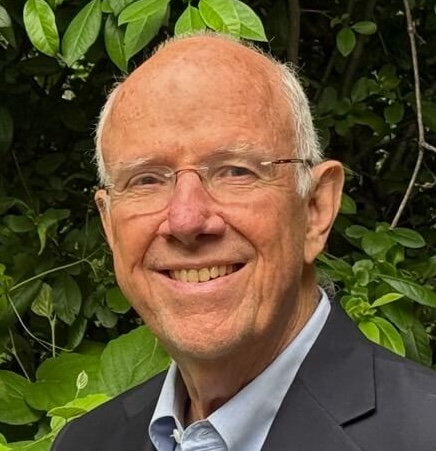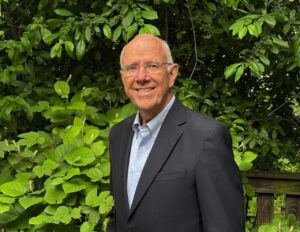
David Hornbeck, Founder, Voices for Restorative Schools
Solving the complex challenges facing public school education requires comprehensive solutions. In 2021, the Maryland General Assembly enacted the Blueprint for Maryland Schools, comprehensive legislation that, among other systemic change initiatives, will result in about 600 of Maryland’s schools being Community Schools.
In my nearly 60 years in public education, I have witnessed the transformational effect of the Community School model on students, families, and educators. I became deeply involved in public school education in Maryland in 1976 when I was appointed State Superintendent of Schools, serving for 12 years. After a variety of other education related jobs, including six years as Philadelphia’s Superintendent of Schools, I returned to Baltimore in 2003.
For most of the last 20 years, I have spent my time involved in leading grassroots education organizing in Maryland, important parts of it based on Baltimore Curriculum Project’s (BCP’s) work. BCP is Maryland’s largest operator of neighborhood conversion charter schools, with its six Baltimore City schools providing exceptional public-school education in the Community School model. The Community School model provides wrap-around services to improve the well-being of students and families, supporting the high-need, underserved communities where schools are located.
I write this blog post to share my thoughts about Restorative Schools, but also because of my deep admiration for the vision of BCP co-founder Muriel Berkeley, the leadership of Laura Doherty, BCP President and CEO, and the extraordinary and persistent commitment and accomplishments of BCP schools. I know from personal experience that BCP schools are exemplars.
My organizing work in Maryland began with an organization designed to expand Community Schools in Baltimore City. It was very much influenced by the work at BCP’s Wolfe Street Academy, a nationally recognized Community School model led by its principal, my son Mark Gaither. In 2011, there was an attempt to roll back city funding for Baltimore’s 18 Community Schools. With leadership from Wolfe Street building grassroots support, that funding was restored.
Addressing Poverty Through the Blueprint for Maryland Schools
In 2016, I founded Strong School Maryland to encourage the Kirwan Commission to offer pathbreaking recommendations that would result in systemic change in Maryland education policy and funding with passage of the Blueprint. Led by Brit Kirwan, it did that with transformational recommendations such as 3- and 4-year-old Pre-Kindergarten, special support for students struggling with reading by the 3rd grade, major new emphasis on career education, innovative provisions to enhance teaching and school leadership, accelerated academic and career opportunities in the 11th and 12th grades. However, a pivotal part of every recommendation included special attention to struggling students, especially those facing the challenges of poverty.
A centerpiece of those recommendations was the provision that every school with 55% or more students eligible for free and reduced priced meals would be a Community School. BCP’s Wolfe Street Academy served as the “model visitation school. Prior to passing the Blueprint, Kirwan, the House of Delegates Ways and Means Committee, among other key actors, visited Wolfe Street to understand how being a Community School plays a dramatic role in the lives of its students and families.
Very importantly, the Blueprint also established the principle that not all poverty is the same, by providing more intense funding support for schools characterized by “concentrated” poverty in addition to the designation and funding associated with being a Community School.
But the Blueprint Missed an Essential Ingredient to Success
The Blueprint is exceptional, visionary legislation, but after its passage, it became clear that there was a large missing feature in the analysis. The Blueprint has no explicit policy or funding support to change school culture.
There are multiple manifestations of poor school culture in Maryland. Five leading indicators are:
- Chronic absenteeism.
- Teacher turnover.
- Mental health challenges.
- Exclusionary discipline imposed more heavily on those who are Black and/or disabled.
- Persistent opportunity/achievement gaps between white students and Black or Hispanic students.
Without a change in school culture, the promise of the Blueprint will fall short of its potential. The culture of every institution is highly determinative of the institution’s success…a church, law firm, legislature, non-profit, business and, yes, the school.
Introducing Restorative Practices to Maryland
Students meditating and practice reflection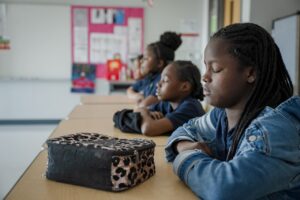
When a school commits to a restorative culture of positive relationships, amazing things happen. It becomes a safer school. It practices and celebrates racial justice, where interactions, decisions, and instruction are done with equity. Staff and students value and listen to each other.
Ultimately, restorative practices cultivate a sense of belonging, safety, and well-being for all members of the school community, which leads to academic success, personal growth, and positive social development for students. That’s what we want for every school and each student in Maryland.
The first time I witnessed a restorative school culture was several years ago when I visited my son, Matt Horbeck, who is Principal at BCP’s Hampstead Hill Academy. We were talking in the hallway when a 2nd grade girl came up to him and said, “If I don’t get a circle within 10 minutes, I’m going to hit so-and-so.” A few minutes later, Matt immediately helped arrange a circle to address the situation.
In a Restorative School, the circle is the central vehicle for implementation. The idea is that if you sit in a circle, everybody has an equal place. Everybody’s able to hear one another, to speak to one another. Most often the circle is in the classroom or in a faculty meeting or between a parent and a teacher and a principal. It may even occur impromptu in a hallway. Wherever it is, there is responsibility and accountability fed by a commitment to positive relationships.
Two things about that day in the hallway with Matt impressed me. One was that a seven-year-old girl would know that there was an alternative to hitting, and second, it was so much a part of the culture of the school that she knew that if she could get to the highest authority in the school, e.g., the Principal, that he might not come down on her side, but he would set up a way to resolve the issue. That’s the kind of school culture that results in schools that work.
Eighteen years ago, Muriel Berkeley, BCP co-founder, brought restorative practices to BCP. With leadership from new principal Dr. Rhonda Richetta, City Springs Elementary / Middle School was the first BCP school in 2007 to establish such an effort as a whole-school strategy to establish a new culture. A year later, Hampstead Hill Academy began its journey to become BCP’s second Restorative School. These schools were the first in Baltimore and Maryland to introduce restorative practices to public education.
What Supports Does a Successful Restorative School Need?
The most effective Restorative Schools must have three things:
- A full-time Restorative Coach.
- Training of all staff in a school before the school begins its restorative journey and annual refresher training.
- Routine use of “the circle” in classrooms for community building, conflict resolution and instruction, for faculty meetings, and interactions with parents.
These two videos tell the restorative practices story.
Watch a video on restorative practices.
Watch a WBALTV story on the impact of restorative practices.
How to Enable All Maryland Schools to Become Restorative Schools
Hampstead Hill’s Leaders Go Places, a restorative-practices-based leadership development program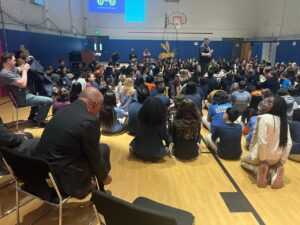
With Strong Schools Maryland, we called the grassroots small groups we organized statewide, Groups of Ten. In Voices for Restorative Practices, We use the same model but call them Circles of Ten because of the central role played by circles.
In 2024, the circles met statewide every month and sent two letters to designated elected officials urging their support for the legislation for all Maryland schools to be Restorative Schools. During the 2024 legislative session, we visited with legislators and dozens of us turned out to support the legislation in committee hearings.
The letters included several from 5th grade Peer Mediators at BCP’s City Springs Elementary / Middle School, who wrote to Bill Ferguson, President of the Maryland Senate, as part of our advocacy efforts. They were among the first people to receive a response stating that he supported restorative practices and was delighted to hear from them. Young people, very frequently, are excellent advocates because legislators will pause long enough to listen to them.
Learn more about BCP’s Peer Mediator program.
We were successful in getting the bill passed in the House by a very large margin, 128-6, but lost traction in the Senate. Because of the fiscal cliff facing the 2025 legislative session, we knew that there was no way that the type of legislation we supported could be passed. We also recognized that there were serious misunderstandings of what Restorative Practices is.
Now, we are focused on educating the people in the Circles of Ten across the state more deeply and using social media to help others understand what restorative practices are. It also helps that the American Federation of Teachers and the National Education Association are both strong supporters of Restorative Practices and allies in this process. We will return to the legislature when the fiscal climate changes.
Addressing Misconceptions About Restorative Schools
Many people think of Restorative Practices as simply a reaction to bad behavior that has already occurred. That’s a big misunderstanding. Instead, restorative practices is an affirmative and preventive measure, designed to create a different mindset in the school.
Being a restorative school doesn’t mean, primarily, that you are reacting to bad behavior that already has taken place. It means changing the culture, so the bad behavior occurs less often in the first place.
A related big misunderstanding is that a Restorative School is “soft” on bad behavior. That could not be more wrong. In the first place, the major strategy is to reduce bad behavior before it happens. Second, when very serious bad behavior occurs such as violence, weapons or persistent bullying suspension can be and is still used promptly. Third, the priority with discipline in a Restorative School is to use measures that actually are known to work and solve the problem, not simply for punishment for the sake of punishment. That perspective not only breeds more bad behavior in the school setting, but it leads very frequently to the school tro prison pipeline.
The final big misunderstanding about restorative practices is that it diverts classroom time away from instruction and student achievement. There is certainly a lot on a teacher’s plate, but the irony is that if you’re an effective Restorative School and an effective restorative classroom, it can produce even more instructional time, because it eliminates, for example, all the “sit down, get in your seats, open your books, get ready to learn” minutes before instruction can start.
Moreover, by reducing chronic absenteeism, teacher turnover and incidents of bad behavior plus relieving conditions that exacerbate mental health challenges, all resulting in improved student achievement, restorative practices create the conditions that are most conducive to teaching and learning.
The Current Status of Maryland Schools as Restorative Schools
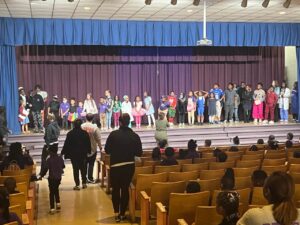
City Springs, A Restorative School
There are a number of Maryland districts that support restorative practices by having full-time district leadership to support the implementation and/or policy statements of support. However, the fidelity of implementation is inconsistent. For example, frequent school leadership changes result in Restorative Schools often getting a principal who is not trained or committed to restorative schools. Training of all of the staff in a school is highly inconsistent. Few schools have full-time restorative coaches. Too often, the concept of restorative practices is more buzzword than reality.
In contrast, schools like Hampstead Hill and City Springs have full-time coaches, regular training, and consistency of implementation, and the results show. Hampstead Hill and City Springs have been great partners for Voices. They serve as “model visitation schools”, much like Wolfe Street did for Community Schools. In addition, they were “on location” for the video we have recently shot that will tell the Restorative Schools story in a manner that we can use statewide to promote the understanding and advocacy of restorative practices.
What Can You Do to Help Make Every Maryland School a Restorative School?
Ultimately, state legislation providing funding and policy standards is necessary if we are to have the impact we seek. We need state policy and money to scale restorative schools across Maryland. The policy needs to provide the standards of implementation and accountability for results. The money needs to be sufficient to support a full-time restorative coach in each school and training for everybody in the entire school, teachers, principals, cafeteria workers, custodians.
You can help.
We’re asking people to invite us to come and speak to community, religious, and civic groups. Use our request form.
Stay abreast of the movement by following us on social media:
Facebook: facebook.com/voicesforrestorativeschools
Visit voicesforrestorativeschools.org to learn more.
